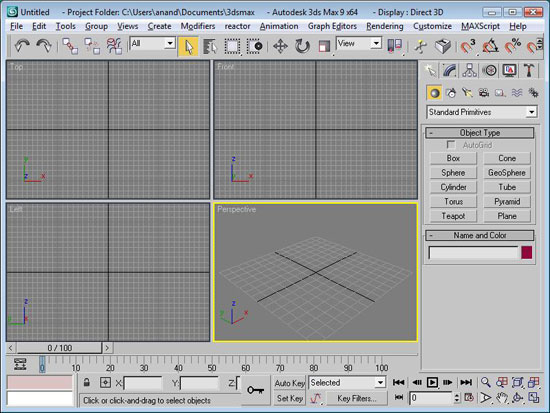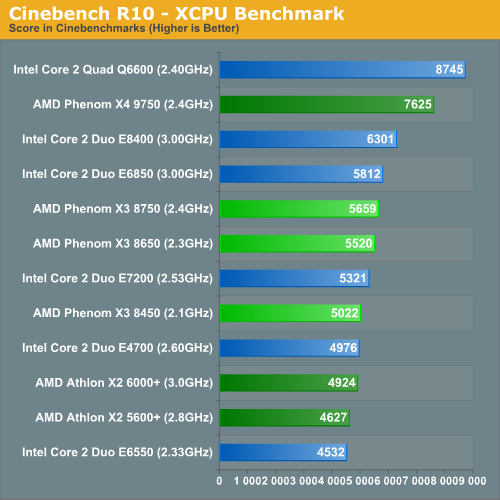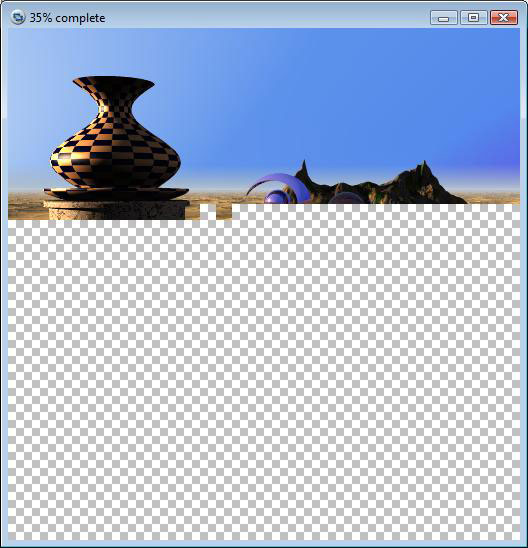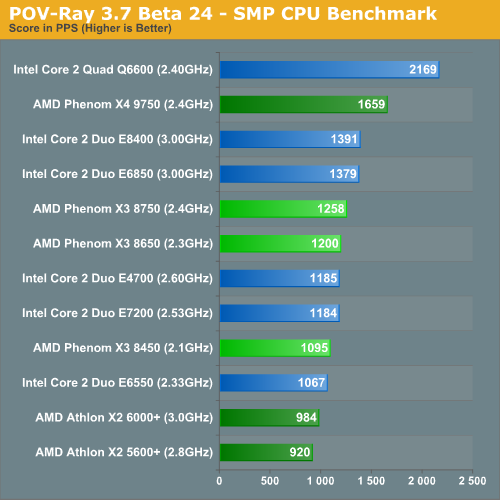AMD's Phenom X3 8000 Series: Fighting Two Cores with Three?
by Anand Lal Shimpi on April 23, 2008 9:00 AM EST- Posted in
- CPUs
3D Rendering Performance
3dsmax r9

Our benchmark, as always, is the SPECapc 3dsmax 8 test but for the purpose of this article we only run the CPU rendering tests and not the GPU tests.
The results are reported as render times in seconds and the final CPU composite score is a weighted geometric mean of all of the test scores.

We've started testing with Windows Vista Service Pack 1, which for some reason really penalizes Intel in our 3dsmax benchmark. The CBALLS2 benchmark (a part of the SPECapc test) runs significantly slower on Intel platforms than it used to, resulting in a far more competitive landscape under 3dsmax.
Thanks to its on-die memory controller, the Phenom X3 is able to remain competitive at lower clock speeds than Intel but the problem is that it's not quite competitive enough. The Core 2 Duo E8400 and Phenom X3 8750 are similarly priced and perform virtually identically here, but the E8400 only has two cores vs. three in the Phenom thanks to a significant clock frequency disparity (3.0GHz vs. 2.4GHz).
Cinebench R10

A benchmarking favorite, Cinebench R10 is designed to give us an indication of performance in the Cinema 4D rendering application.

Competing within AMD, the Phenom X3 8650 is around 12% faster than the Athlon X2 6000+, and the 8450 almost 9% faster than the equivalently priced Athlon X2 5600+. The problem is that both chips are about the speed of Intel's Core 2 Duo E7200 and not even the fastest X3 8750 can outperform the Core 2 Duo E6850.
AMD continues to offer a reasonable upgrade to Socket-AM2 motherboard owners who are lucky enough to be on AMD's compatibility list, but falls short of being anything but an mild alternative to Intel at this point.
POV-Ray 3.7 Beta 24

POV-Ray is a popular raytracer, also available with a built in benchmark. We used the 3.7 beta which has SMP support and ran the built in multithreaded benchmark.











45 Comments
View All Comments
bgd73 - Monday, April 28, 2008 - link
I read a few pages from a 1360 page book about computer repairing, in the history section. It was big nm back then, big power going wild... it states 1mhz for 1mbyte transfer. No wonder I think my 2.8e from 2003 before all your multicore quibbling is still just as decent as modern times...with 2 cores not quite bragged about. They are simply organizing cpus more than ever and reducing the die size. Keeping performance of the first of dual cores is as far as it may go for years...until the mhz is increased. 2800 mhz as a width is as wide as it goes. Organizing it does bring performance, like defragging a drive. Furthermore, if software knows how to use it...other software running simultaneous is losing..just like an old "hack me cuz I am errored forever" single core. Single cores are done, clean up that room with at least 2 thread cpus, that is all I found to be with 2 or more threads..very strong stable,secure, won't blip to a light switching on in the same room on the same circuit. The rest is marketing, they have to say something don't they...gochichi - Saturday, April 26, 2008 - link
These processors are all "good" but this performance mark is not the "holy grail", I'd like to see more performance over time, as I'm used to.I recently switched to Intel, and you know, I'm happy with their prodcuts. I think AMD needs to get moving, their product's weakness isn't good for the industry.
Both Nvidia and Intel have no competition, their job is just to maximize their profits on old research and development rather than actually competing under pressure.
hoelder - Friday, April 25, 2008 - link
If AMD would create and express team on the Processor side, take the best die implementation they currently have, lock the doors and over and over 24/7 cast new dies until they have a mass producible Opteron 4 core or Phenom 4x with 4 GHz, then they are where the should be today. Because in the end it's the CPU clock. And with every smaller die add cores and cache, it is plausible. Intel can afford that of course, but has also a tail of people involved. With a smaller team you can create miracles and with good enthusiasm on the exec level, that works.haplo602 - Thursday, April 24, 2008 - link
What about linux kernel compilation with j2/3/4/6/8 ??? I'd like to see that comparison ...MrMilli - Thursday, April 24, 2008 - link
Your power usage chart is a bit deceiving.In the article you mention that Windows Media Encoder is actually hardcoded to only support powers of two number of cores. Still you use this for measuring the power on a Phenom X3. So basically the 3th core is just idling.
I think that's the reason there is such a big gap between the X3 and X4.
enjoycoke - Thursday, April 24, 2008 - link
I think Intel won't be releasing their new platform until 3rd Quater because they have been having such a good run with their current platforms already and will be taking a bit of a breather against AMD and other rivals.They really need constant profits to keep their stock price in line and thats what matter most.
Archibald - Thursday, April 24, 2008 - link
It is appears, that if one ignores the 1-10% performance increase(s), the dual-core is plenty for a casual power user (i.e. non-gamer). After all, the multi-core Si-HW is here, but the SW arena is a chaotic battlefield:....Justin Rattner, an Intel Senior Fellow, recently promoted to take over Intel R&D has been quoted as saying that the clock wars of the past two decades will be replaced with ?core wars? over the next few decades. ?Intel & Microsoft are working feverishly on developing ?Concurrent Programming Languages? to effectively take advantage of the concurrent processor architectures that represent the future of the industry. ?Multicore processors require concurrent software:?The Free Lunch Is Over? (for software developers)., for more see this: http://tinyurl.com/62986h">http://tinyurl.com/62986h.
I tend to favor AMD's approach with 780/790 and Brisbane, although marketing of this combo might be a challenge, from an engineering point of view it may be a decent (quite usable) design.
Comment: Is the UI design of this blog from the Stone Age?
derek85 - Thursday, April 24, 2008 - link
I think AMD just released the perfect CPU to go with their 780G platform for a HTPC:- Low cost
- Lower power consumption
- HT3 to boot graphics memory bandwidth for better performance
- Multi-core horsepower for better encoding/decoding
Phenom is much mightier than Athlon X2 when it comes to multimedia. Now there is just no more reason to choose a similarly priced K8 over this.
ap90033 - Thursday, April 24, 2008 - link
Wow "perfect"? Slower in gaming, check. Slower clock for clock than Intel check. Pehnom 9850 cost more than Q6600 check. lolderek85 - Thursday, April 24, 2008 - link
If it's for a gaming PC I would agree ... but I think I said HTPC. Cheapset X3 is only $150, $50+ cheaper than a Q6600, and will do this job just fine with less heat and power consumption.